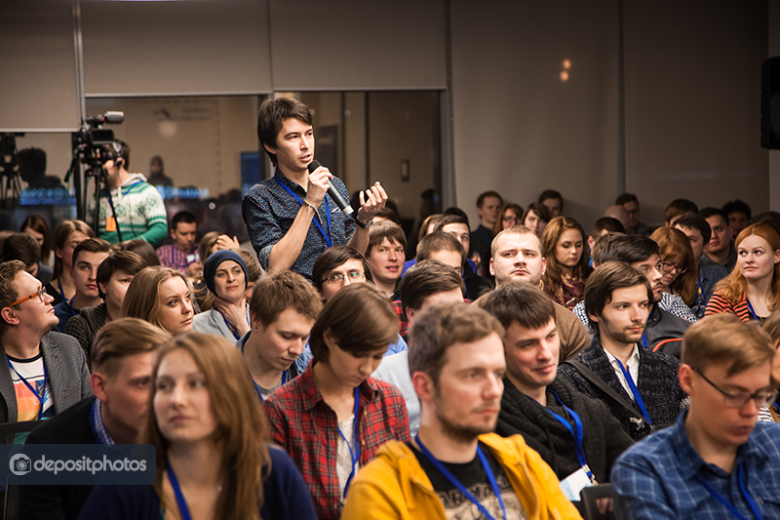Microconference UX-Environment №24: Long-reads and modern tools of publishing
On April 1, the twenty-fourth UX-Wednesday microconference, dedicated to long-reads and modern publishing tools, was held at the Mail.Ru Group office. Invited guests, as well as specialists from different departments of the company, made a series of presentations about their work experience and participated in the discussion. This time we had Nikita Obukhov (Tilda), Maxim Pavlov (Notamedia), Igor Kochmala (KP), and also Kirill Danchenko (Readymag) via Skype. The discussion was moderated by Tanya Smirnova (DepositPhotos).


')

Like last time, we started with a teleconference. Kirill Danchenko , co-founder and CEO of one of the first Readymag publishing platforms , spoke about the history of its creation, current opportunities and development plans. He showed early versions of the interface and described how the second co-founder Anton Gerasimenko saw a future in which the designer himself could create promotional websites, presentations and journalism on the web without the help of developers. It was at the dawn of the current boom of similar services, so Readymag can be considered as co-authors of the trend.

After the break, a panel discussion began with the participation of Nikita Obukhov, Maxim Pavlov and Igor Kochmala. We prepared in advance a list of sensible topics for discussion from the experts and alternated them with questions from the audience. About 130 people came, many of whom represented the leading domestic media - Sanoma, Channel One, RBC, NTV, Esquire, Russia Today, TASS and others, so it was interesting to communicate both during the panel and during the breaks.

The experts represented three key parties working on the creation of long-media - media ( KP ), platform ( Tilda ) and web-studio ( Notamedia ). This allowed to look at the problem from all angles. After a brief talk about themselves and the projects that the discussion participants were working on, a discussion began on trends, successful techniques and patterns, market characteristics, the nuances of working with the editors and advertisers. Here are some of the topics:

The event is open - we invite not only speakers, but also listeners from other companies. If you want to speak with us - write to me at y.vetrov@corp.mail.ru and we will choose an interesting topic of the story and a convenient date for it. You can find out the schedule and program of future events, as well as sign up for them on the Facebook page of the microconference .
Available photos from UX-Environment number 24 , as well as the tape of announcements on Twitter . Read also reports about previous events .


')

Like last time, we started with a teleconference. Kirill Danchenko , co-founder and CEO of one of the first Readymag publishing platforms , spoke about the history of its creation, current opportunities and development plans. He showed early versions of the interface and described how the second co-founder Anton Gerasimenko saw a future in which the designer himself could create promotional websites, presentations and journalism on the web without the help of developers. It was at the dawn of the current boom of similar services, so Readymag can be considered as co-authors of the trend.

After the break, a panel discussion began with the participation of Nikita Obukhov, Maxim Pavlov and Igor Kochmala. We prepared in advance a list of sensible topics for discussion from the experts and alternated them with questions from the audience. About 130 people came, many of whom represented the leading domestic media - Sanoma, Channel One, RBC, NTV, Esquire, Russia Today, TASS and others, so it was interesting to communicate both during the panel and during the breaks.

The experts represented three key parties working on the creation of long-media - media ( KP ), platform ( Tilda ) and web-studio ( Notamedia ). This allowed to look at the problem from all angles. After a brief talk about themselves and the projects that the discussion participants were working on, a discussion began on trends, successful techniques and patterns, market characteristics, the nuances of working with the editors and advertisers. Here are some of the topics:
- Komsomolskaya Pravda is one of the pioneers of the format in Runet. Due to the fact that content for large articles is always ready in the print version and the need to synchronize with it the publication online, they collect long reads within a week. Their first experience, “ America of Boarded Up Skyscrapers, ” was also within this framework. At the time of the UX-environment, they were preparing to switch to Tilda and new materials are already being collected on this platform.
- A year ago, Nikita Obukhov was preparing to launch Tilda and wanted to make life easier for designers and publishers. In fact, he had to actively engage in grocery work in addition to improving the supply of materials and expanding the collection of modules. It turned out that the need is not so great - many do not think about the effectively presented content, do not know how to do it, and why. So Nikita has to form a market, this activity is especially noticeable for the last six months.
- It was not possible to collect a clear opinion on one of the main business issues - which exhaust give long-reads. The panelists agreed that this is just another format for submitting publications in addition to the existing arsenal, which also provides image exhaust. We at Mail.Ru Group still have a little experience of launching long-reads, but one of the recent examples with the series “ Fizruk ” gave a powerful exhaust - 33% completed this long page to the end, 90% of visitors to the page watched the series. For us, this was an example of how the effectiveness of such publications can be considered.
- Most agreed that advertising in such publications does not make sense - rather, Long Read itself should be a commercial special project, if you plan to earn money on it.
- The mobile web continues to actively increase its share, and publication transitions are obtained in many ways from social networks, which are also being consumed more and more from smartphones. Support for these devices is easy to organize if Long Read is done on a proprietary or third-party platform, but for manual projects it is quite long and expensive.
- One of the promising areas of development of the format is the addition of interactive and game mechanics, when the reader actively interacts with the long reader. Something like that is trying to do B-O-S .

The event is open - we invite not only speakers, but also listeners from other companies. If you want to speak with us - write to me at y.vetrov@corp.mail.ru and we will choose an interesting topic of the story and a convenient date for it. You can find out the schedule and program of future events, as well as sign up for them on the Facebook page of the microconference .
Available photos from UX-Environment number 24 , as well as the tape of announcements on Twitter . Read also reports about previous events .
Source: https://habr.com/ru/post/265243/
All Articles